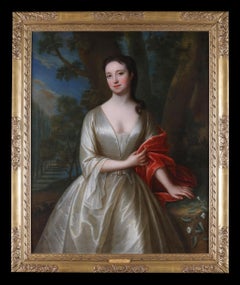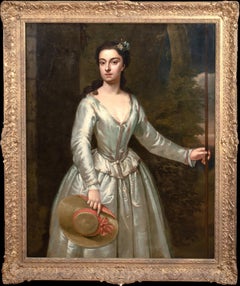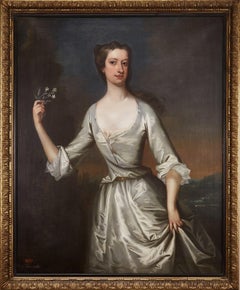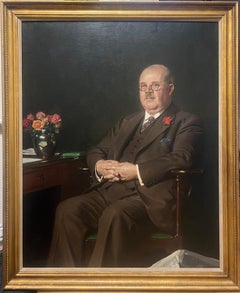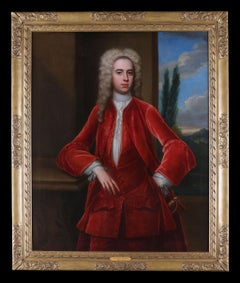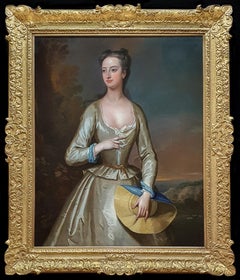Charles Jervas Art
Irish, 1670-1739
Charles Jervas was born in Dublin in 1675 who later lived in England. After moving to England, Jervas became an apprentice to the painter Sir Godfrey Kneller. He later studied drawing in Rome and then returned (c. 1709) to England. Succeeding Kneller, he became court painter to the English kings George I and George II. His home became a centre for literary figures, among them Alexander Pope and Jonathan Swift, whose portraits Jervas painted, in addition to that of George II (1728). He produced a translation of Miguel de Cervantes’s Don Quixote (published posthumously, with his surname spelled Jarvis, in 1742).to
4
4
Overall Width
to
Overall Height
to
4
4
1
3
4
3
3
1
1
1
1
1
4
4
3
3
4
8,779
2,809
1,642
1,313
4
4
Artist: Charles Jervas
Portrait of a Lady possibly Frances Thynne, Lady Worsley 1673-1750 Oil on canvas
By Charles Jervas
Located in St. Albans, GB
Charles Jervas
Possibly Frances Thynne, Lady Worsley 1673-1750
Oil on Canvas
Picture Size: 50 x 40"
Outside Frame Size: 58 x 48"
1675 – 1739
Charles Jervas, who was born in Clonli...
Category
Early 1700s English School Charles Jervas Art
Materials
Oil
Portrait Of Lady Margaret Hasting, as a Shepherdess 18th Century CHARLES JERVAS
By Charles Jervas
Located in Blackwater, GB
Portrait Of Lady Margaret Hasting, posing as a Shepherdess 18th Century
CHARLES JERVAS (1675-1739)
Large 18th Century portrait of Lady Margaret Hasting, oil on canvas, by Charles J...
Category
18th Century Charles Jervas Art
Materials
Oil, Canvas
$9,362 Sale Price
20% Off
English 18th century portrait of Henrietta Pelham-Holles, Duchess of Newcastle.
By Charles Jervas
Located in Bath, Somerset
Portrait of Henrietta Pelham-Holles (née Godolphin) (1701-1776), Duchess of Newcastle, standing in a wooded landscape with a river beyond, three-quarter length wearing an ivory silk ...
Category
1720s Old Masters Charles Jervas Art
Materials
Canvas, Oil
Portrait Of 1st Baron Hawkstone, Sir Rowland Hill, Tory MP for Lichfield
By Charles Jervas
Located in Blackwater, GB
Portrait Of 1st Baron Hawkstone, Sir Rowland Hill, Tory MP for Lichfield (1705-1783)
by Charles JERVAS (1675-1739)
Large 18th Century portrait of Baron Hawkstone, Sir Rowland Hill,...
Category
18th Century Charles Jervas Art
Materials
Canvas, Oil
$12,115 Sale Price
20% Off
Related Items
Huge British Mid 20th Century Portrait of a Bank Manager Signed Oil Painting
Located in Cirencester, Gloucestershire
The Bank Manager
by Stuart Scott Somerville (1908-1983)
signed oil on canvas, framed
Framed: 56 x 47 inches
Canvas: 50 x 40 inches
Provenance: private collection, UK
Condition: very ...
Category
Mid-20th Century English School Charles Jervas Art
Materials
Oil, Canvas
The Barrister Fine Antique English Huge Oil Painting Portrait of Lawyer Gent
Located in Cirencester, Gloucestershire
The Barrister (the sitter is James Guy Baker, the artists brother).
by Gladys Marguerite Baker (British, 1889-1959)
signed
oil painting on canvas, framed
framed: 146cm x 101cm
canva...
Category
Early 20th Century English School Charles Jervas Art
Materials
Canvas, Oil
1830's British Oil Painting Large Portrait of a Distinguished Gentleman
Located in Cirencester, Gloucestershire
Portrait of an English Gentleman
English School, circa 1830's period
oil on canvas, unframed
Canvas: 30 x 24.5 inches
Provenance: Private collection, UK
Condition: relined canvas, ov...
Category
Early 19th Century English School Charles Jervas Art
Materials
Oil, Canvas
1850's Portrait of British Officer in Red Military Uniform Antique Oil Painting
Located in Cirencester, Gloucestershire
Military Portrait of a British Officer
English School, mid 19th century
unsigned
oil on canvas, framed
Framed: 33 x 28 inches
Canvas : 24...
Category
Mid-19th Century English School Charles Jervas Art
Materials
Oil
Portrait King Henry 8th VIII Antique English Painting Famous Monarch
Located in Cirencester, Gloucestershire
King Henry VIII
English artist, circa 1840's
oil on paper laid on board, framed
framed: 10.5 x 10inches
board: 8 x 7.5 inches
inscribed verso
provenance: private collection, UK
cond...
Category
Early 19th Century English School Charles Jervas Art
Materials
Oil
$1,307
H 10.5 in W 10 in
Portrait of Lady Caroline Price
By George Romney
Located in Miami, FL
DESCRIPTION: Perhaps the best Romney in private hands. If Vogue Magazine existed in the late 18th century, this image of Lady Caroline Price would be ...
Category
1970s Old Masters Charles Jervas Art
Materials
Oil, Canvas
Fine 17th Century Dutch Old Master Oil Painting Interior Scene Many Figures
Located in Cirencester, Gloucestershire
Alms for the Poor
by Richard Brakenburg (Flemish 1650-1702)
oil on canvas, unframed
Canvas: 25 x 30 inches
Provenance: private collection, France, extensively inscribed verso
Conditi...
Category
17th Century Old Masters Charles Jervas Art
Materials
Oil, Canvas
Fine Large 1800's English Oil Country Gentleman in Parkland before Stately Home
Located in Cirencester, Gloucestershire
The English Gentleman and his Country House
English artist, circa 1800-1820 period
Fine Georgian period portrait of a young English gentleman, seated with distant view of his country...
Category
Early 19th Century English School Charles Jervas Art
Materials
Oil, Canvas
Large 1970's British Portrait of a Lawyer/ Barrister in Wig Signed Oil Painting
Located in Cirencester, Gloucestershire
The Legal Gentleman
portrait of a lawyer/ barrister
by Victor Hume Moody (British 1896-1990) *see notes below
signed and dated 1974
oil on canvas, unframed
canvas: 36 x 28 inches
pro...
Category
1970s English School Charles Jervas Art
Materials
Oil, Canvas
Victorian Oil Charming London Park Scene with Dapper Gentleman Smoking & Horses
Located in Cirencester, Gloucestershire
Dapper Gentleman in the London Park
by Philip Henry Rideout (British, late 19th century)
signed & dated 1895
oil on canvas, framed
Framed: 17.5 x 14.5 inches
Canvas : 12 x 10 inches
...
Category
Late 19th Century English School Charles Jervas Art
Materials
Oil
Portrait of Gentleman Blue & Cloak, Portrait of Lady, Fine Carved Gilded frames
Located in London, GB
Portrait of a Gentleman with Blue Cloak and Portrait of a Lady in Russet Dress c.1697
Thomas Murray (1663-1735)
These fascinating portraits are exquisite examples of portraiture in ...
Category
17th Century Old Masters Charles Jervas Art
Materials
Oil, Canvas
$27,880
H 37.8 in W 33.47 in D 2.76 in
Fine 1820's English Georgian Large Portrait of a Country Lady seated with Quill
Located in Cirencester, Gloucestershire
Portrait of a Country Lady, depicted Seated wearing a silk glove and with a Quill Pen
English artist, circa 1820's, unsigned
oil on canvas, unframed
canvas: 35 x 29 inches
provenance...
Category
Early 19th Century English School Charles Jervas Art
Materials
Oil, Canvas
Previously Available Items
Portrait of a Man possibly Arthur Viscount Irwin, Temple Newsam Oil on canvas
By Charles Jervas
Located in St. Albans, GB
Charles Jervas
Possibly Arthur, 6th Viscount Irwin (Temple Newsam)
Oil on Canvas
Picture Size: 50 x 40"
Outside Frame Size: 58 x 48"
1675 – 1739
Charles Jervas, who was born in Cl...
Category
Early 1700s English School Charles Jervas Art
Materials
Oil
Portrait of Hannah Clements as a Shepherdess c.1730; by Charles Jervas
By Charles Jervas
Located in London, GB
This elegant and graceful portrait is said to represent Hannah Clements (1710-1781) nee Gore. Painted by Charles Jervas - who was in 1723 appointed to the post of King’s Painter by George I and in 1725 to George II - it is one of his finest and most impressive examples. Jervas was considered the supreme practitioner of female portraiture in the 1720s and 1730s, and was the foremost successor to Sir Godfrey Kneller after the latter's death in 1723. Presented in an outstanding carved and gilded antique frame, a remarkable work of art in itself.
The sitter is captured in a moment of relaxation in a country landscape. Jervas continued the idiom of Sir Godfrey Kneller, his master, whilst introducing a new ease and suggestion of informality into his portraits. By depicting the sitter within the landscape with sheep Arcadian simplicity is being suggested. This draws from the tradition of pastoral literature and by the early 17th century was already popular in art; all educated individuals were familiar with Latin and Greek pastoral poetry. The mythological world of Arcady was an idyll that the ladies and gentlemen of the Court could inhabit in the guise of shepherds and shepherdesses. The pastoral tradition in literature and plays had been embraced by an aristocratic class since classical times. Life in the country was perceived as peaceful, contemplative and free of worry of hardships, a time to pursue pleasure. To be painted in such a manner created a tangible expression of power and wealth. When the portrait was painted the pastoral was so ingrained that the mere inclusion of such elements suggested Arcadia to the viewer. And this is further emphasised by painting the light to reflect sunset and the suggestion of tranquillity. Of course, the sitter did not live in such a place and this masterful painting was a flight from chaos to a tranquil world.
Hannah Catherine Clements (nee Gore) (1710-1781) was the daughter of Rev. William Gore (and granddaughter of Sir William Gore, 3rd Baronet), and Honora Prittie. She married Nathaniel Clements (1705-1777), an important Irish politician and financial figure, in January 1730. Nathaniel became the main financial manager of the British and Irish Government in Ireland during the period, and was de facto Minister for Finance from 1740 to 1777. He had an extensive property portfolio, including Abbotstown, County Dublin, estates in County Leitrim and County Cavan and was developer of property in Dublin, including part of Henrietta Street where he lived at No. 7 from 1734 to 1757 in what was described as “Parisian luxury”. The couple had six children.
Charles Jervas was born in Clonliske in Kings Country, Ireland in 1675. He received his artistic training in Kneller’s studio and was later, by the 1690’s, Kneller’s assistant. According to Vertue Jervas made small copies of the Raphael cartoons, then at Hampton Court, in about 1698 and sold them to Dr George Clarke of All Souls, Oxford who lent him £50 to embark on the then essential ‘grand tour’ in 1699. Taking in Paris and settling in Rome by 1703, he furthered his artistic training and became a voracious copyist of the old masters. George Vertue noted that he was known as “Carlo Jervasi” and was a “good, engenious painter”. On his return to London in 1709 Tatler (15th April 1709) remarked that he was 'the last great painter Italy has sent us' and noted that he “painted many ladies as shepherdesses and country girls”. The style that he cultivated made him Kneller's natural successor when that artist died in 1723.
In 1727 he married a widow, Penelope Hume, a lady of considerable means (£20,000). In September 1738 he travelled to Italy seeking some reprieve from his asthma, returning in May 1739. He died in November that year and bequeathed £1000 to his friend, Pope, should he outlive his widow: this did not happen as she survived until 1747. The following spring his considerable art collection was sold in 2265 lots in a sale lasting 9 days.
Apart from royalty Jervas gained the patronage of many of the ruling and intellectual elite. He moved in the highest circles of the literary and social world and became an intimate of Sir Robert Walpole and the poet Alexander Pope, to whom he gave drawing lessons.
Jervas’ portrait of Elizabeth Felton, of Playford, Later Countess of Bristol (1677-1741) realised £45,410 at Christies London 11th June 2002, lot 13. His portrait of Lady Barbara North realised £42,050 at Christies London 11th July 2008, lot 55.
Titan Fine Art are pleased to offer this work, which is representative of the artist’s best work.
Provenance: Private collection, Beal House...
Category
18th Century Old Masters Charles Jervas Art
Materials
Canvas, Oil
H 60.24 in W 50.4 in D 3.15 in
English 18th century portrait of Henrietta Pelham-Holles, Duchess of Newcastle.
By Charles Jervas
Located in Bath, Somerset
Portrait of Henrietta Pelham-Holles (née Godolphin) (1701-1776), Duchess of Newcastle, standing in a wooded landscape with a river beyond, three-q...
Category
1720s Old Masters Charles Jervas Art
Materials
Canvas, Oil
Portrait of William Townshend
By Charles Jervas
Located in Bath, Somerset
Attributed to Charles Jervas (Ireland 1675-1739 London) Portrait of William Townshend (1702-1738), three- quarter length, standing in a landscape wearing a red velvet coat...
Category
18th Century and Earlier Old Masters Charles Jervas Art
Materials
Oil
Charles Jervas art for sale on 1stDibs.
Find a wide variety of authentic Charles Jervas art available for sale on 1stDibs. You can also browse by medium to find art by Charles Jervas in canvas, fabric, oil paint and more. Much of the original work by this artist or collective was created during the 18th century and is mostly associated with the Old Masters style. Not every interior allows for large Charles Jervas art, so small editions measuring 41 inches across are available. Customers who are interested in this artist might also find the work of Studio of Sir Peter Lely, Flemish School, 17th Century, and Sir Godfrey Kneller. Charles Jervas art prices can differ depending upon medium, time period and other attributes. On 1stDibs, the price for these items starts at $19,172 and tops out at $19,172, while the average work can sell for $19,172.
